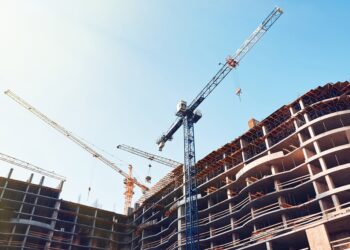Indian residential real estate rebounds despite rising interest rates, construction costs, global inflationary pressures and other distressing trends
BY VISHAL DUGGAL
Despite rising interest rates and prices, the real estate industry in India is pegged for growth in the future. In particular, residential real estate
appears to be on its path to recovery, after a prolonged slowdown. Housing prices increased by up to 11 percent annually across eight major cities during January-March 2022 as compared to the year-ago period. Housing Price-Tracker 2022 report by realtors body CREDAI, real estate
consultant Colliers and data analytics firm Liases Foras attributes this to a rise in demand for residential properties and a sharp hike in building material costs for almost two years.
Significantly, the January-March quarter of 2022 witnessed new launches similar to the pre-COVID level. It is expected that sales will continue to grow despite the recent increase in repo rates by the Reserve Bank of India (RBI) as part of monetary tightening measures being adopted by
central banks worldwide to curb mounting inflation levels, the rise in the prices of raw materials and in global inflation levels as well as geo-political tensions in the wake of the prolonged Russia-Ukraine war, impacting crude oil prices, and disrupting supply chains. These negative factors have not majorly impacted the demand in the real estate sector in the housing segment, which continues to remain strong. According
to online real estate major PropTiger.com, the sharpest uptick in property prices was registered in Chennai, where the average rate of properties has undergone a 9 percent appreciation in the past year. Pune and Ahmedabad followed this southern market closely in terms of price increase, with both markets witnessing an 8 percent rise in their average property rates.
Further, according to a Reuters poll of property analysts, property prices in India are expected to increase 7.5 percent on a pan-India basis this year, the fastest growth in five years, and rents are likely to go up too. The poll of 13 property analysts was held over May 11-27. According to the poll, prices in Mumbai and Delhi, including the National Capital Region, are expected to rise between 4 percent and 5 percent this year and next. Prices in Bengaluru and Chennai are forecast to rise 5.5 percent to 6.5 percent over the course of the next two years.
According to another industry data, there has been a three percent decline in unsold housing inventory across the top seven cities—Delhi-NCR, Mumbai, Chennai, Kolkata, Hyderabad, Bengaluru and Pune— from Q1 2020 till Q1 2022, from 6,44,420 units to 6,27,280. The unsold inventory has come down despite fresh inventory in the form of post-Covid launches. In the seven major cities new inventory collectively saw a 116 percent jump, from 41,220 units in Q1 2020 to nearly 89,150 units in Q1 2022. In terms of the ultra-luxury segment priced at ₹2.5 crore, these cities saw total new inventory of nearly 4,370 units of which Mumbai comprised a 32 percent share while the NCR comprised a 31 percent share. Hyderabad followed with nearly 23 percent share.
A PLETHORA OF POSITIVE FACTORS
The real estate sector contributes 5 percent to 6 percent of the GDP in India. This is expected to rise to 13 percent of GDP by 2025 as the market is estimated to touch $1 trillion by 2030, driven by rising demand. Further, it is estimated that around 88 crore people will be living in urban areas by 2051 as against the current 46 crore, creating huge potential for real estate development.
The real estate industry supports close to 250+ ancillary industries in the country. According to a report published by IMARC Group, “India Real Estate Market: Industry Trends, Share, Size, Growth, Opportunity and Forecast 2022-2027”, the Indian real estate market is expected to rise at a CAGR of 9.60 percent between 2022 and 2027.
Further, FDI inflows into Indian real estate have jumped over three-fold to $23.9 billion during the 2017-21 period as compared to the previous five years. According to a Colliers-FICCI report, total investments in Indian real estate stood at $49.4 billion during the 2012-21 period, of which 64 percent came from foreign investors.
The housing demand has continued to sustain thanks to the ebbing of Covid-19. In fact, the Indian real estate sector that remained largely resilient during the pandemic, is now showing signs of revival. Though, according to the latest ANAROCK Research data, as a result of increased
property prices and lending rate hikes, the top 7 cities saw housing sales moderate by 15% – from approx. 99,550 units in Q1 2022 to approx. 84,930 units in Q2 2022, However, Anuj Puri, Chairman – ANAROCK Group explains, “Given that we saw two back-to-back quarters of robust housing sales and new launches (Q4 2021 and Q1 2022), a dip was to be expected.”
It has been seen that buyers now prefer ready-to-move-in projects as compared to those under construction. This trend has led to a major price difference between finished and under-construction projects as people want to be sure that they get what they pay for instead of investing in
what may or may not be completed. Overall, the real estate market has recovered after the bruising impact of the pandemic, largely due to the pent-up demand finding fulfillment and end-users buying ready-to-move-in projects.
In a heartening development, home loan disbursal grew by 13.7 percent to ₹17.09 lakh crore for FY22. According to an ICRA report, housing finance in FY23 is expected to grow in the range of 17 percent to 20 percent.
Post-Covid, the hybrid mode of work has led to migration of skilled workforce to satellite cities around metros and tier II cities. This shift to the peripheral regions or outer remote areas of cities has fuelled the demand for larger spaces on the back of the growing importance of owning a
home and the enhanced spending capacity of buyers. The focus has shifted to owning a home rather than renting. Buyers, especially millennial, continuously focus on projects, which provide state-of-the-art amenities and world-class facilities.
All these indicators point to an encouraging outlook for residential real estate sector this year and beyond.








